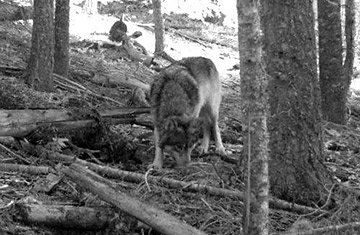
This Nov. 14, 2011, photo from a trail camera appears to show OR7, the young male wolf that has wandered hundreds of miles across Oregon and Northern California looking for a mate and a new home
Up in Lassen County, a remote and rugged slice of northeastern California, there's a homecoming under way. In 1924 the Golden State's last known gray wolf was exterminated there as part of a purge of a beast long feared as the eater of sheep, cows and, according to legend, little girls. Now Lassen is where a lone wolf — the first known member of his species on California soil in nearly 90 years — has decided to settle in for the winter. The radio-collar-wearing wolf, known as OR7 to scientists, took a 300-mile (480 km), zigzagging trek away from his pack in northeastern Oregon, crossing the border into California on Dec. 28. His growing legion of fans call him Journey, and he has stayed put in a sagebrush-covered high-desert region known as the Modoc Plateau for more than a week.
"This is probably the most significant conservation story for this state and this species in decades," says Amaroq Weiss of the California Wolf Center, an education, research and breeding facility in San Diego County, who cited a decade-old study that determined that the state's northeastern corner could probably support about 450 wolves. "To have a wolf set foot in the state when the last one was killed in 1924 is spectacularly big news."
But not everyone is ready to welcome Journey with open arms — especially ranchers worried about what the possibly expanding presence of wolves might mean for their livestock. "At the moment, it's more of a curiosity than anything else," says Jack Hanson, treasurer of the California Cattlemen's Association, who runs about 400 head of cattle in Lassen County, about 17 miles (27 km) from Journey's current whereabouts. "However, the reintroduction and repopulation of wolves in California would raise the same concerns as it has in Oregon and Idaho and Montana and Wyoming. We would prefer that it didn't repopulate, and if it does, we certainly want to be intimately involved with our fish and game department in developing management plans and strategies." Such strategies might one day include reimbursement for ranchers who can prove that a wolf took their livestock, a program that has produced some success in other states.
To make sure that angry ranchers or ambitious hunters don't take matters into their own hands, the state's department of fish and game this week sent out a reminder that shooting the wolf is illegal because it's protected by the Endangered Species Act. "We want people to recognize that you cannot kill the wolf," says the department's Jordan Traverso, who is also helping hunters differentiate wolves from coyotes, which are legal to shoot. "It is federally protected, and there are fines and penalties resulting from a wolf kill." And they're pretty serious — punishment could mean a fine of up to $100,000 and a year in jail.
But Carter Niemeyer, who began his work with wolves under the U.S. Fish and Wildlife Service in the 1980s, recently penned a popular memoir called Wolfer and personally put a collar on OR7's mother about six years ago, says wolves have never been a major cause of death for sheep and cattle. "Anecdotal stories give the impression that wolves are a bigger problem affecting many more people than can actually be proven," says Niemeyer. "Documentation is important to keep in perspective what's really going on."
As to fear for human safety, Niemeyer is even blunter. The animals "are not the least bit concerned about people," says the wolf expert, who never packed a gun during his fieldwork. "In three decades of chasing wolves around, trying to get close to them, counting them, going into their dens and looking for pups, I've never had even a slightly close call. The wolves run away, always."
People, says Niemeyer, should probably be more worried about this lone wolf's survival. Though it's exhibiting natural "dispersal" behavior — whereby a young male leaves his pack in search of his own territory and a mate — Journey has wandered into a land where there hasn't been a confirmed wolf sighting since 1924, in the middle of what could be a harsh winter. "His principal occupation right now is staying alive," says Niemeyer, explaining that wolves prefer big game like deer and elk but can get by on ground squirrels and rabbits and by scavenging. "That's even more important than finding a mate and making a territory — keeping his belly full."
If Journey stays put, manages to find a mate that no one knows is there and establishes his own pack, then California conservationists, cattlemen and wildlife-control agents will be left to hash out the details. "It's certainly possible that wolves will recolonize here. It's historically habitat for them, and we are preparing for that," says Traverso, whose department of fish and game has been actively collecting information from elsewhere for years. "It's not the first wolf in the world or even in the United States. We are learning a lot from the other states' experiences."
In the meantime, wolf lovers like Rob Klavins — whose organization Oregon Wild has been a big proponent of wolf expansion and was responsible for the name Journey — are celebrating wherever the wolf goes. "The purposeful extermination of wolves in the last century is one of our greatest environmental tragedies, and for most Americans, their recovery stands alongside that of bald eagles and gray whales as one of our greatest success stories," Klavins explains. "It's a testament to how far we've come as a society."
